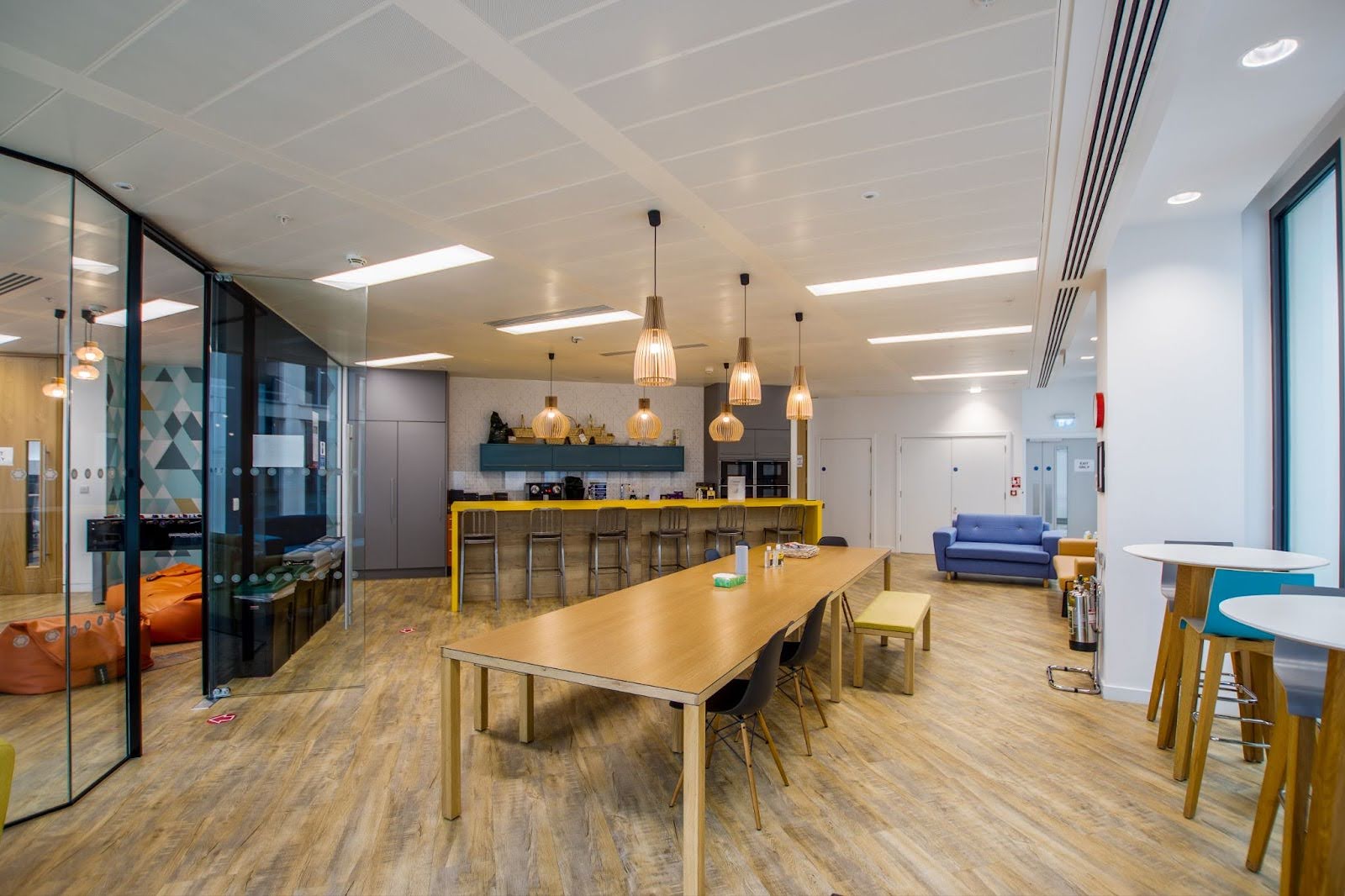
You can spend a fortune on the perfect office space, only to find it doesn’t work the way your team does. Maybe the layout feels cramped, or your members struggle to focus and connect. In a fast-paced environment like Singapore, an uninspiring workspace can hold your business back.
The right office setup isn’t just about style. It’s about functionality, flexibility, and comfort. That’s where smart coworking space design ideas come in. When done well, they support productivity, creativity, and a stronger sense of community.
In this guide, you’ll find practical, modern design solutions to transform your coworking space into one that people love walking into and want to stay in.
1. Centralised Seating Arrangement
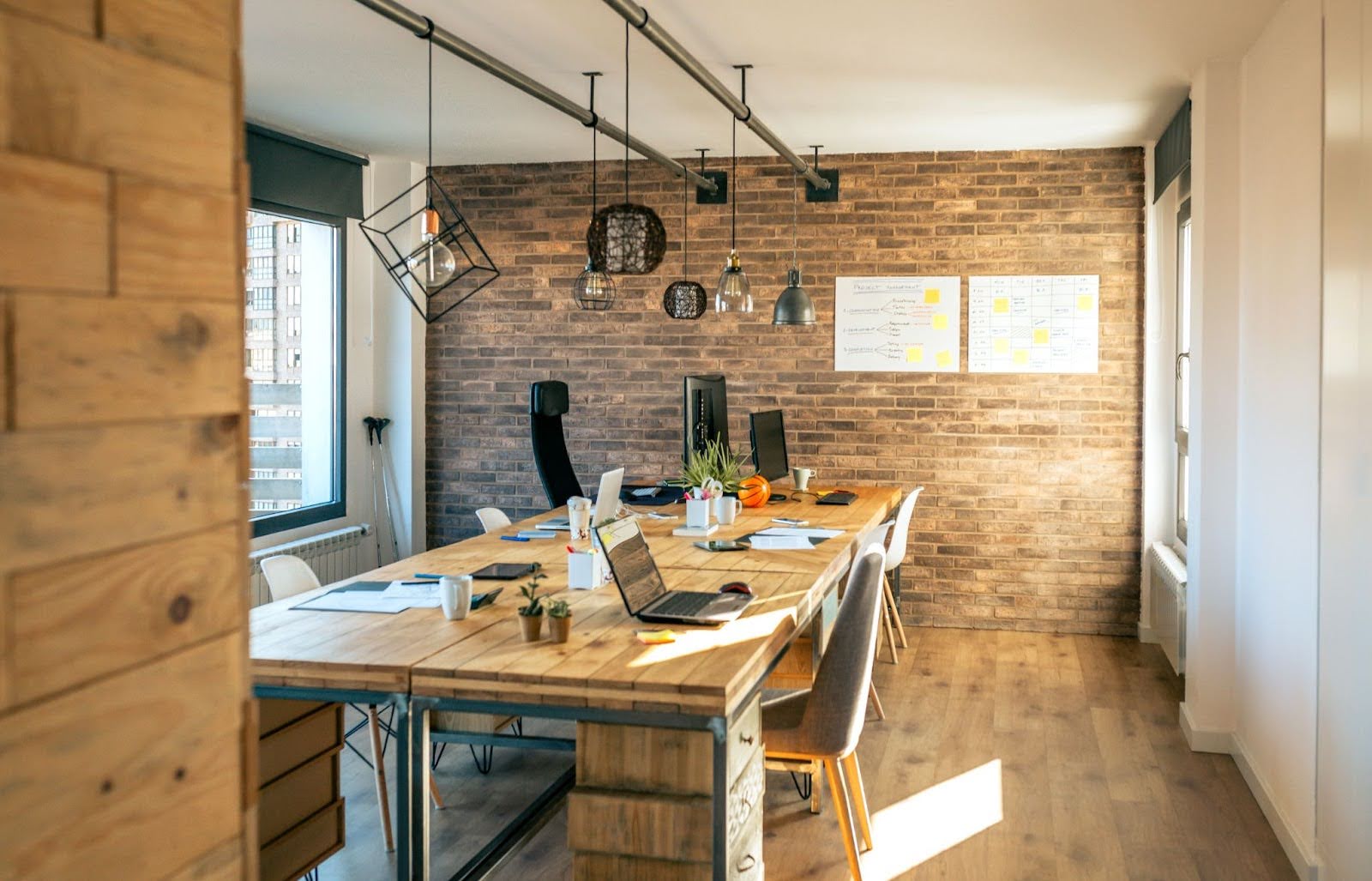
A centralised seating layout places teams around a shared hub to improve communication and collaboration. It’s a smart coworking space design idea that breaks down barriers and encourages spontaneous teamwork.
Instead of isolating employees in distant desks or corners, this design keeps people within easy reach of each other. That means faster feedback, fewer delays, and a more connected culture.
Here’s why it works well for Singapore offices:
- Improves Collaboration: Having everyone seated around a central hub makes it easy to chat, ask questions, or brainstorm without booking a meeting room.
- Increases Visibility: Managers and team leads become more accessible, which can boost trust and reduce miscommunication.
- Supports a Sense of Community: With fewer physical dividers, teams feel more united and engaged.
Pro tips to get started:
- Surround your central area with meeting rooms and breakout zones for privacy when needed.
- Use rounded or long shared tables to encourage interaction.
- Keep walkways wide enough to avoid clutter but maintain the sense of openness.
This setup is ideal for dynamic teams and startups that thrive on flexibility, fast decision-making, and a shared sense of purpose.
2. Open Concept Layout
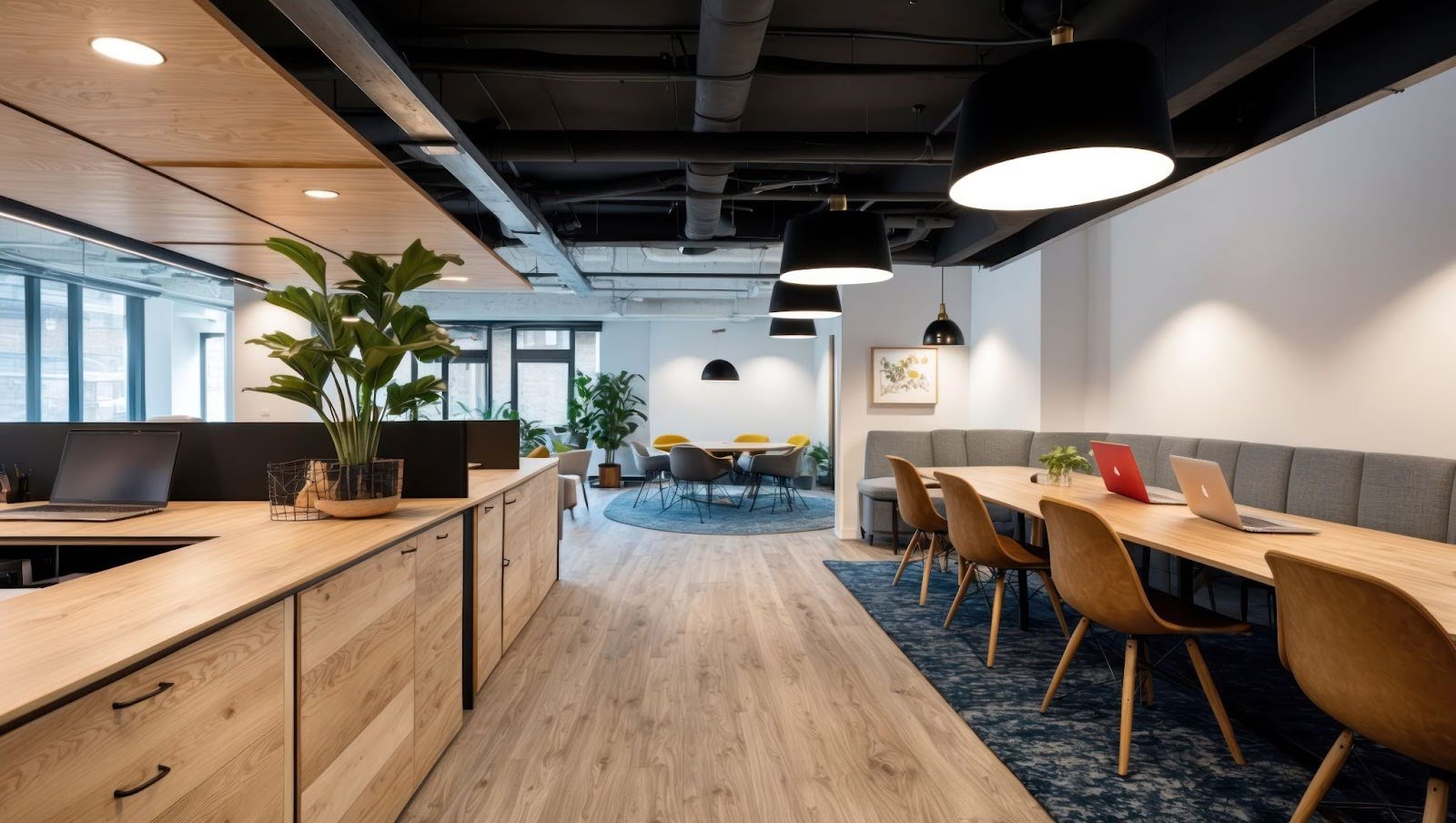
An open concept layout removes physical barriers to create a shared, flexible workspace that encourages interaction and idea-sharing. It’s one of the most effective coworking space design ideas for boosting collaboration without sacrificing comfort.
By eliminating cubicles and walls, team members can engage more freely. This setup supports both casual conversations and quick project updates without the need for formal meetings.
Here’s why open layouts are popular in Singapore coworking spaces:
- Encourages Spontaneous Collaboration: People are more likely to help or bounce ideas off one another when they’re in sight.
- Maximises Floor Space: Open areas make small offices feel larger and more versatile.
- Enhances Natural Light Flow: With fewer obstructions, sunlight can fill the room and improve mood and energy.
To make it effective:
- Add quiet zones and private pods for focus work and confidential calls.
- Use low-profile furniture and glass partitions to define spaces without closing them off.
- Incorporate soft furnishings or plants to reduce noise and add warmth.
This layout works best for modern businesses that value communication, speed, and a vibrant team energy.
3. Biophilic Elements
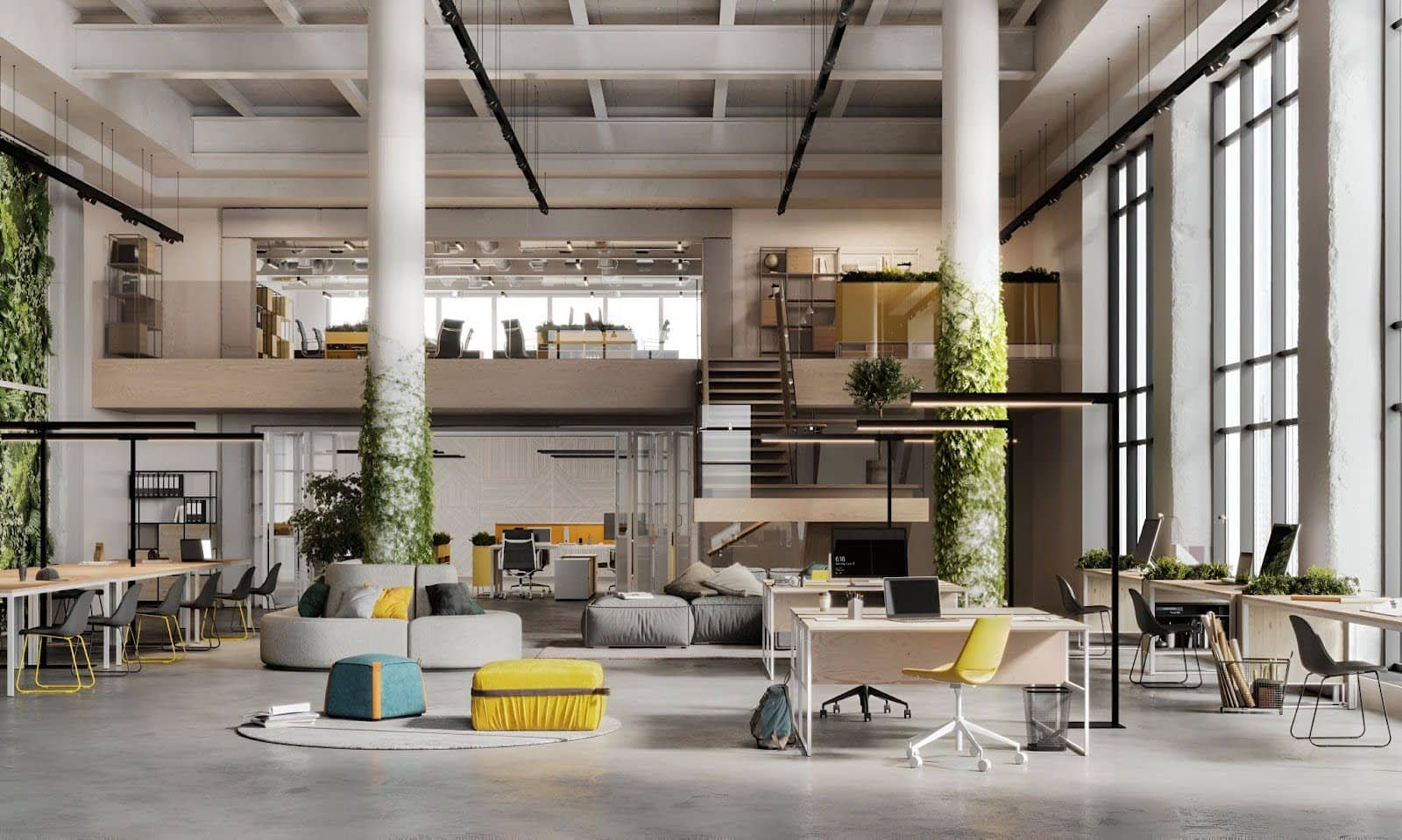
Biophilic elements use natural features like plants, wood, and sunlight to create a healthier, more inspiring workspace. It’s a coworking space design idea that blends nature with modern functionality to support wellness and productivity.
When people are surrounded by greenery and natural materials, they tend to feel calmer and more focused. This is especially valuable in high-energy environments like coworking spaces.
Key benefits of biophilic design:
- Reduces Stress: Greenery has a proven calming effect, which helps reduce anxiety and tension during busy workdays.
- Boosts Productivity: Access to natural light and plant life can improve focus and mental clarity.
- Improves Air Quality: Plants filter the air and create a fresher environment for teams to work in.
Easy ways to implement it:
- Add potted plants, vertical gardens, or eco-walls to shared and private areas.
- Use wood, bamboo, or stone finishes for desks and flooring.
- Maximise natural light by placing workstations near windows and using glass walls.
4. Flexible Furniture Setups
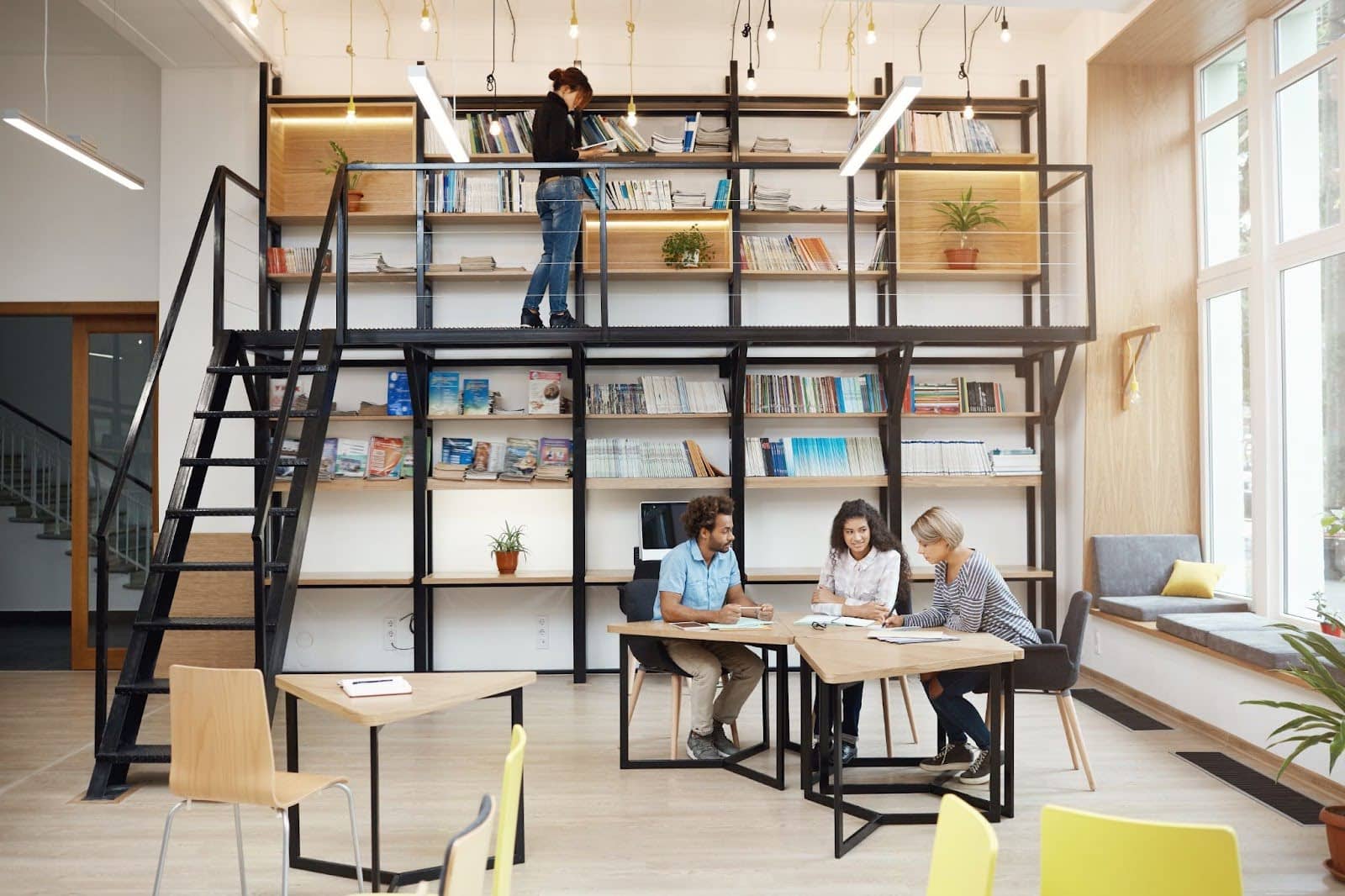
Flexible furniture setups use movable, modular pieces that adapt to changing team needs and activities. This coworking space design idea is perfect for businesses that value agility and versatility.
Instead of rigid desks and static layouts, flexible setups allow users to rearrange their space based on the task at hand. It’s ideal for growing teams, freelancers, or rotating project groups.
Why it works for coworking offices:
- Adapts Quickly: Tables, chairs, and pods can be shifted to create group work zones, solo work areas, or event setups in minutes.
- Maximises Utility: One area can serve multiple purposes throughout the day.
- Encourages Movement: Rearranging furniture reduces monotony and keeps energy levels high.
Implementation tips:
- Use stackable chairs, folding tables, and mobile whiteboards.
- Invest in ergonomic hot desks that offer plug-and-play access.
- Include lounge seating and modular pods near windows or breakout zones.
5. Stylish, Elevated Pantries
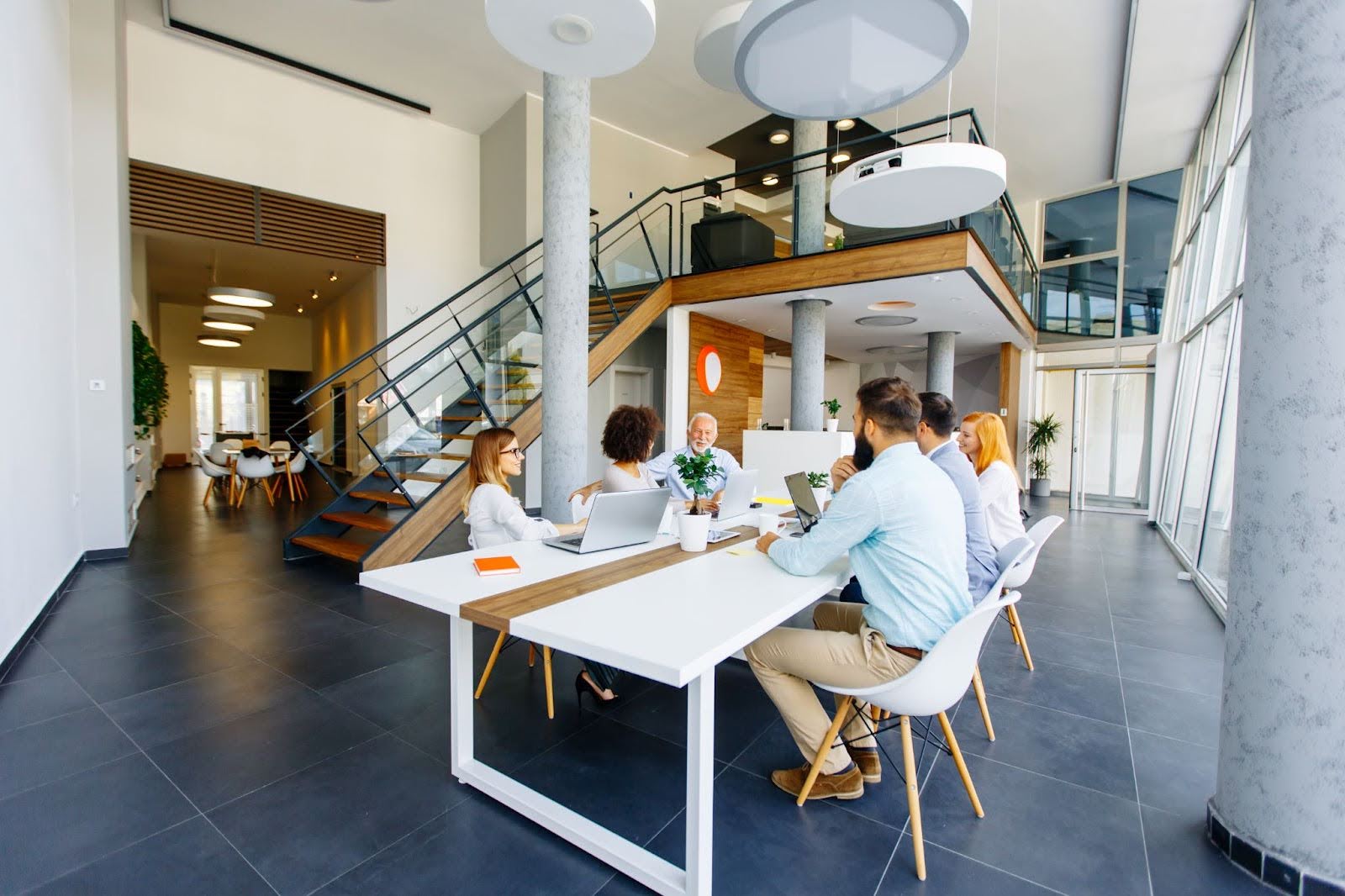
Stylish, elevated pantries are more than just kitchen corners—they’re community hubs that support relaxation, casual chats, and meaningful connections. This coworking space design idea transforms break time into an opportunity for bonding and creativity.
In coworking spaces, a well-designed pantry becomes a destination. It’s where people unwind, share ideas, and build relationships in a relaxed setting.
Benefits of an elevated pantry area:
- Promotes Social Interaction: Coffee breaks often lead to unexpected collaborations or new business ideas.
- Improves Member Satisfaction: A welcoming pantry adds comfort and convenience, especially during long work hours.
- Encourages Work-Life Balance: It creates space to step away, reset, and return more focused.
Design suggestions:
- Use comfortable lounge seating, bar stools, and round tables.
- Choose stylish materials like wood, marble, or metallic accents for a café-like feel.
- Stock healthy snacks, drinks, and basic amenities to make it functional and inviting.
6. Luxurious Lounge Areas
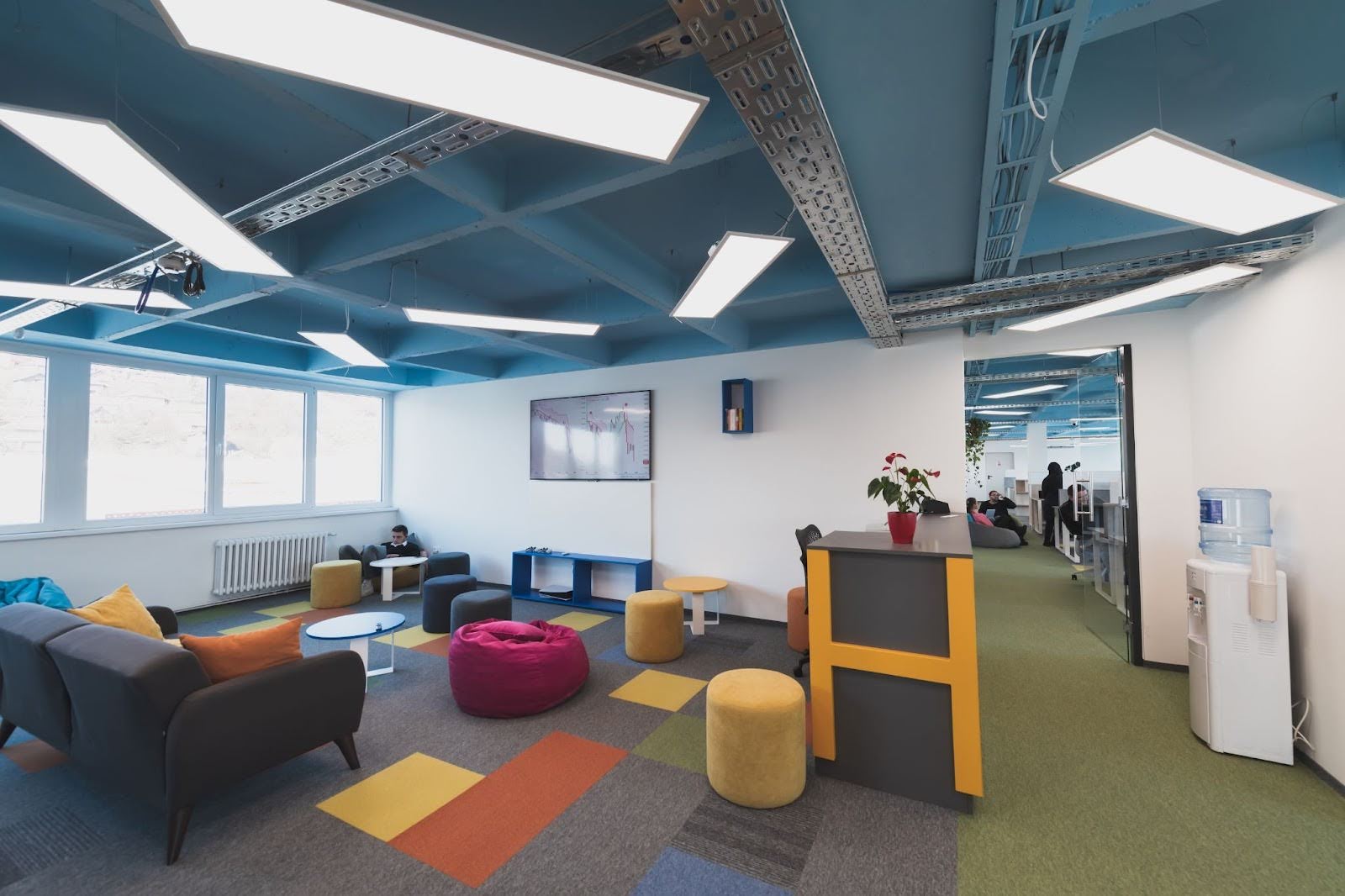
Luxurious lounge areas create a high-comfort space where members can relax, recharge, or have informal meetings. This coworking space design idea brings a hospitality touch to your office, making it feel more like a boutique hotel than a traditional workplace.
A lounge doesn’t just look good—it adds emotional value to your space. It tells members they’re welcome to take breaks, reflect, or socialize in a place that feels indulgent yet professional.
Why lounges matter in coworking spaces:
- Enhance First Impressions: Plush furnishings and elegant lighting leave a lasting impression on clients and guests.
- Support Mental Wellness: Soft seating, warm tones, and ambient lighting help reduce stress and encourage rest.
- Encourage Informal Collaboration: Members are more likely to brainstorm and bond in relaxed settings.
Design elements to include:
- Use velvet or leather sofas, accent chairs, and large coffee tables.
- Layer with textured rugs, floor lamps, and framed art or mirrors.
- Place lounges near reception, pantry, or breakout areas for accessibility.
7. Tech-Optimized Workstations
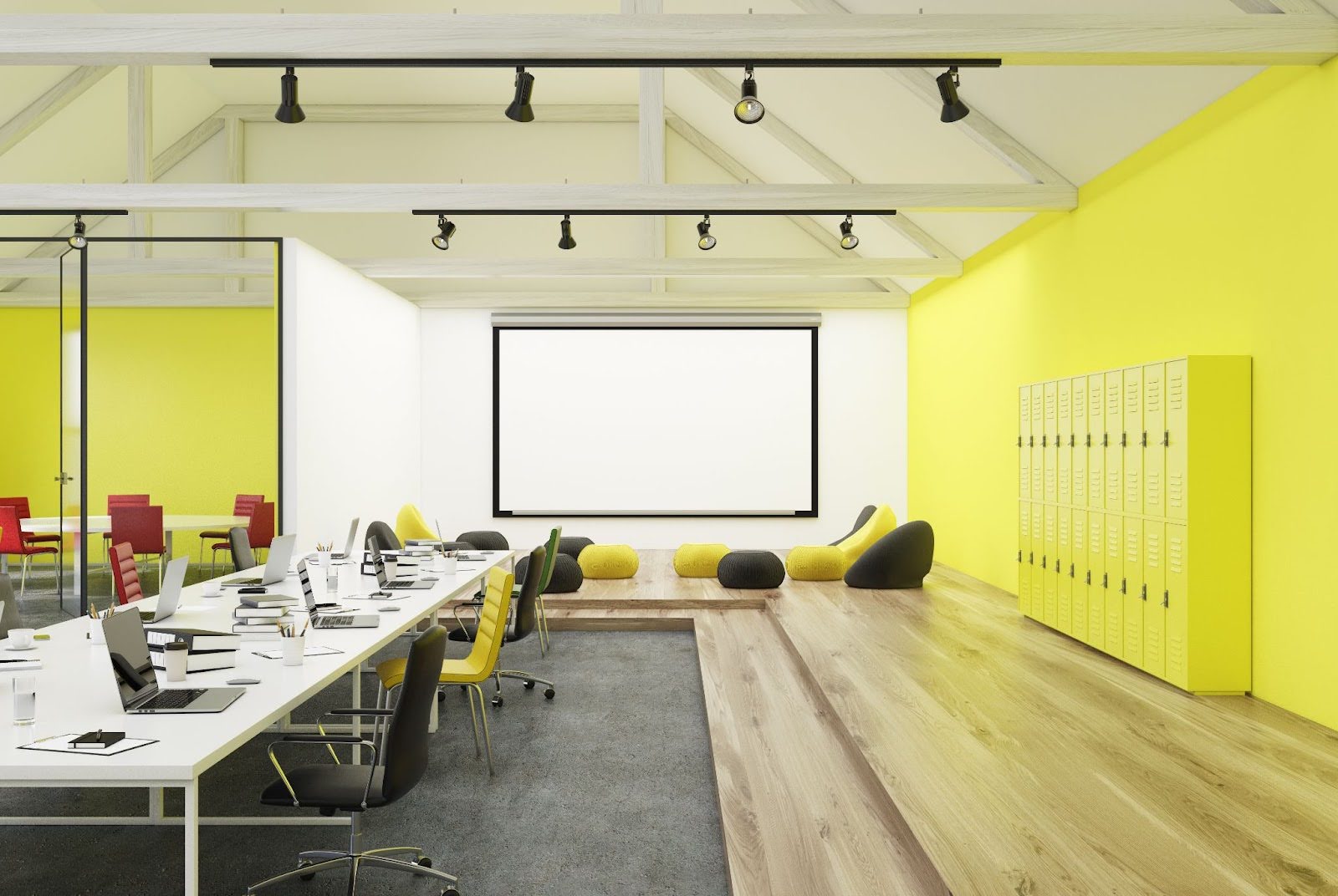
Tech-optimized workstations are designed to support modern digital workflows by integrating power, connectivity, and ergonomic features. This coworking space design idea ensures members can plug in and start working with zero friction.
Today’s professionals expect seamless access to technology. Whether it’s freelancers or corporate teams, your workspace needs to meet their digital demands.
Key benefits:
- Boosts Efficiency: Built-in power outlets, USB ports, and wireless charging save time and reduce cable clutter.
- Enhances Comfort: Ergonomic chairs and adjustable desks help prevent fatigue and improve focus.
- Attracts Digital Nomads: Tech-friendly setups are a major draw for members who work remotely and travel often.
Smart workstation features to consider:
- Desks with integrated cable management and wireless charging pads.
- Ergonomic seating with lumbar support and adjustable heights.
- Extra monitors, LED desk lights, and docking stations for laptop users.
8. Meeting Rooms With Personality
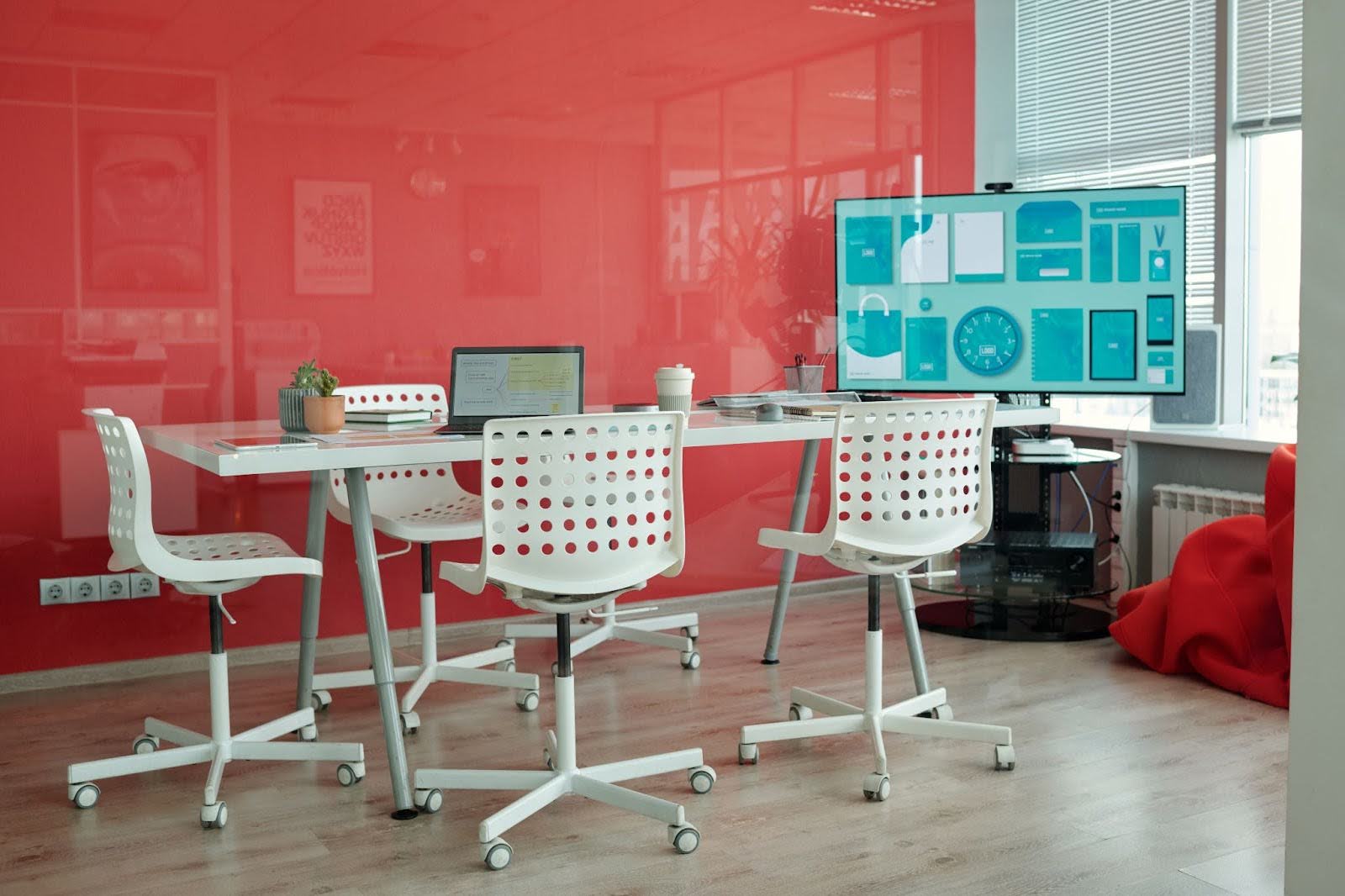
Meeting rooms with personality go beyond function—they reflect your brand and inspire creative thinking. This coworking space design idea turns routine meetings into memorable experiences.
Instead of generic white walls and plastic chairs, thoughtful design can transform these spaces into vibrant, comfortable, and motivating environments.
Why this matters:
- Elevates Professionalism: A stylish, well-equipped room leaves a strong impression on clients and partners.
- Inspires Creativity: Unique themes or decor stimulate fresh thinking and better engagement during meetings.
- Supports Brand Identity: Custom design helps reinforce your workspace’s overall aesthetic and values.
Design tips to bring personality in:
- Use statement lighting, textured walls, or custom murals to add character.
- Include comfortable chairs, quality AV equipment, and adjustable lighting.
- Offer a mix of small and large rooms to suit different team sizes and meeting styles.
9. Phone Booths & Zoom Pods
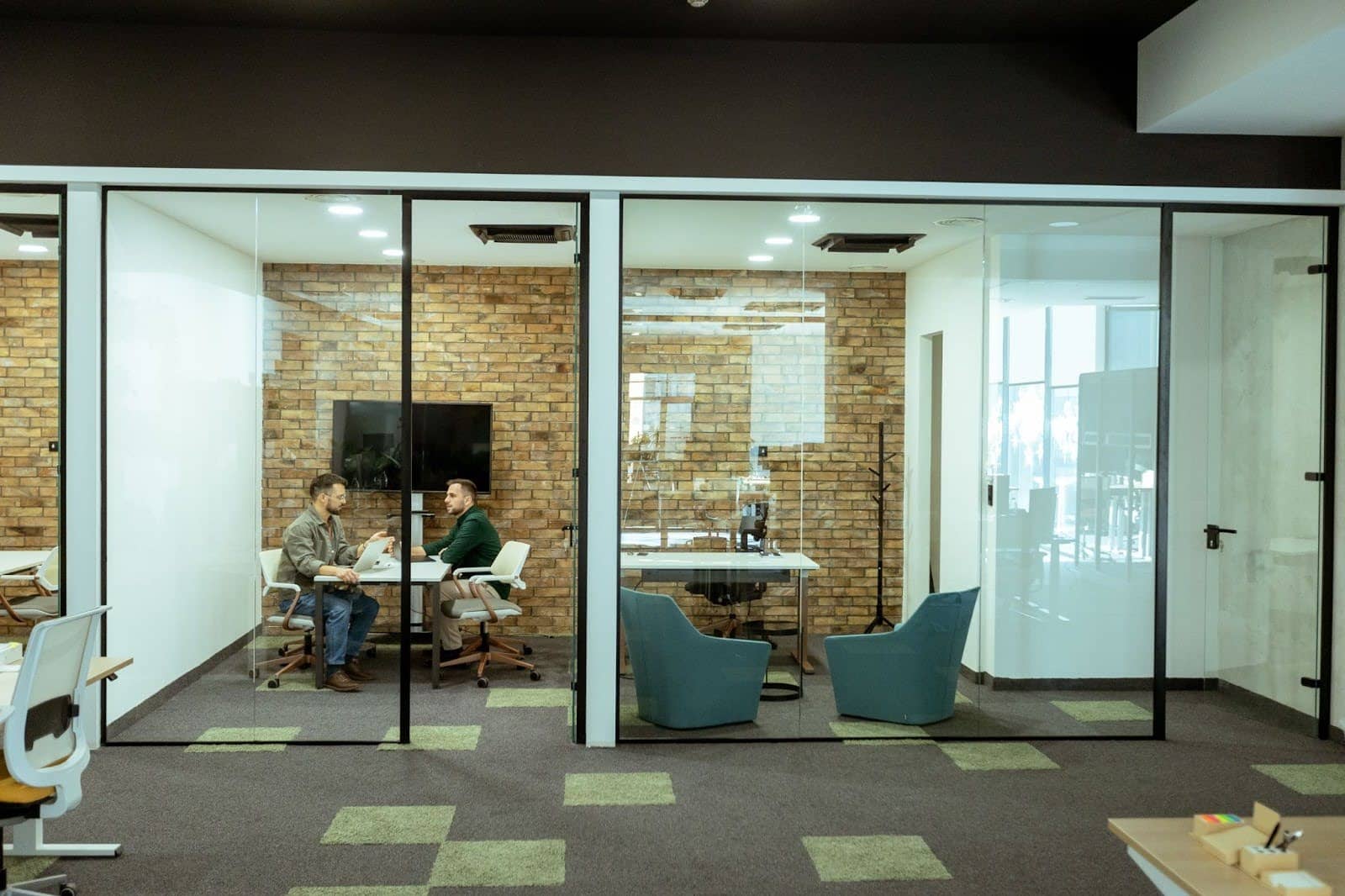
Phone booths and Zoom pods are compact, sound-insulated spaces where members can take private calls or join virtual meetings without disturbing others. They are essential coworking space design ideas in today’s video-first work culture.
In an open-concept office, noise and lack of privacy can be a major issue. These booths solve that problem without needing large meeting rooms.
Why they’re a must-have:
- Maintain Focus: Reduces background noise, helping members stay professional during calls.
- Protects Privacy: Offers a secure space for sensitive discussions or client meetings.
- Maximises Use of Space: Compact pods are efficient even in smaller floor plans.
Implementation ideas:
- Use glass-fronted booths for a modern look with acoustic insulation.
- Include laptop stands, power outlets, and comfortable seating inside.
- Place multiple booths in high-traffic zones to ensure accessibility.
10. Instagrammable Interiors
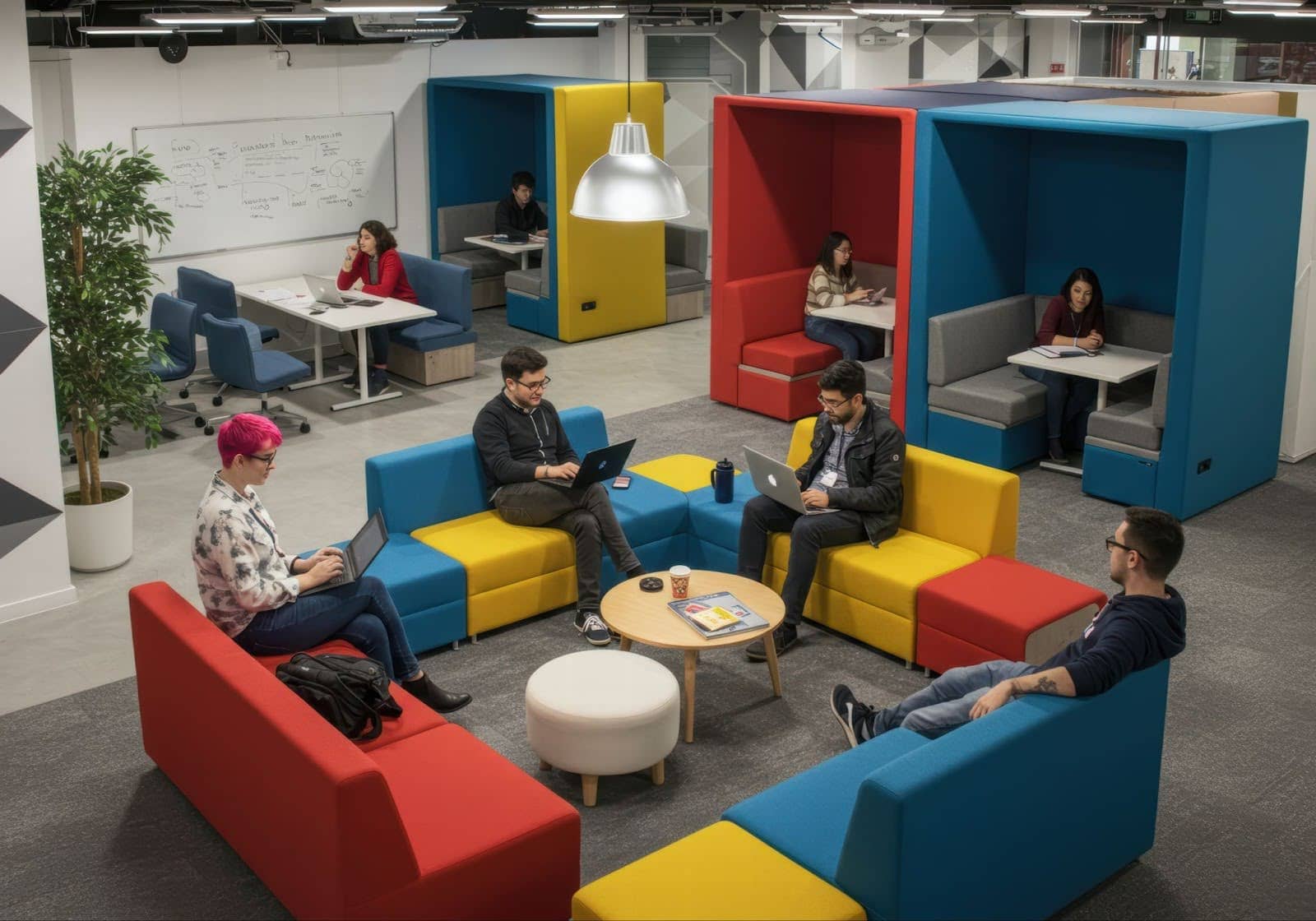
Instagrammable interiors are visually striking spaces designed to be photographed and shared online. This coworking space design idea helps you attract attention, boost brand visibility, and appeal to younger, image-savvy professionals.
In today’s digital world, people often choose spaces that not only function well but also look great in photos. A stylish, photogenic workspace encourages members to showcase your brand on their social media.
Why it works:
- Free Marketing: Members naturally promote your coworking space by posting their surroundings online.
- Attracts Millennials and Gen Z: Aesthetics matter to younger workers who value design and self-expression.
- Enhances Brand Identity: Unique design elements make your space instantly recognizable.
Easy ways to make your space Instagram-worthy:
- Use bold murals, neon signs, or creative lighting installations.
- Add feature walls with textured finishes or branded quotes.
- Incorporate curated furniture pieces and stylish decor accents.
11. Nature-Inspired Quiet Zones
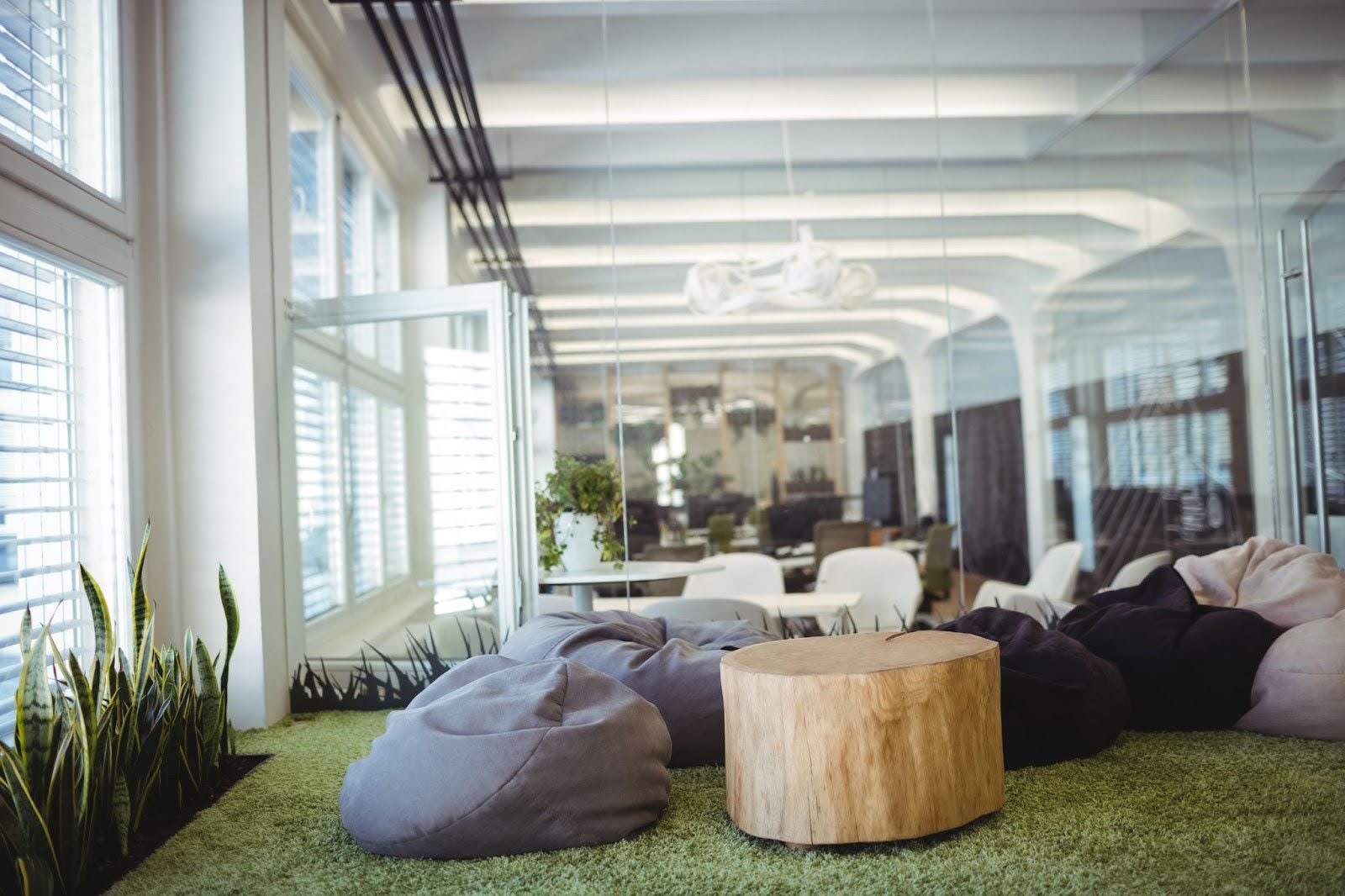
Nature-inspired quiet zones are peaceful areas designed with natural elements to help members recharge and focus. This coworking space design idea supports mental wellness and deep work by offering calm, restorative spaces away from the main hustle.
Not every task requires collaboration. Sometimes, members need stillness to concentrate, reflect, or reset.
Why quiet zones matter:
- Boosts Focus: Low-noise areas reduce distractions, improving productivity during solo work.
- Promotes Well-Being: Nature-themed designs help lower stress and create a sense of calm.
- Offers Balance: Provides a mental break from high-energy zones without leaving the office.
Design features to include:
- Use earthy tones, natural materials, and soft textures like felt or cork.
- Add potted plants, wood paneling, or mini water features for sensory calm.
- Keep lighting warm and low, with individual lamps or indirect LED strips.
12. Member Spotlight Presentation Areas
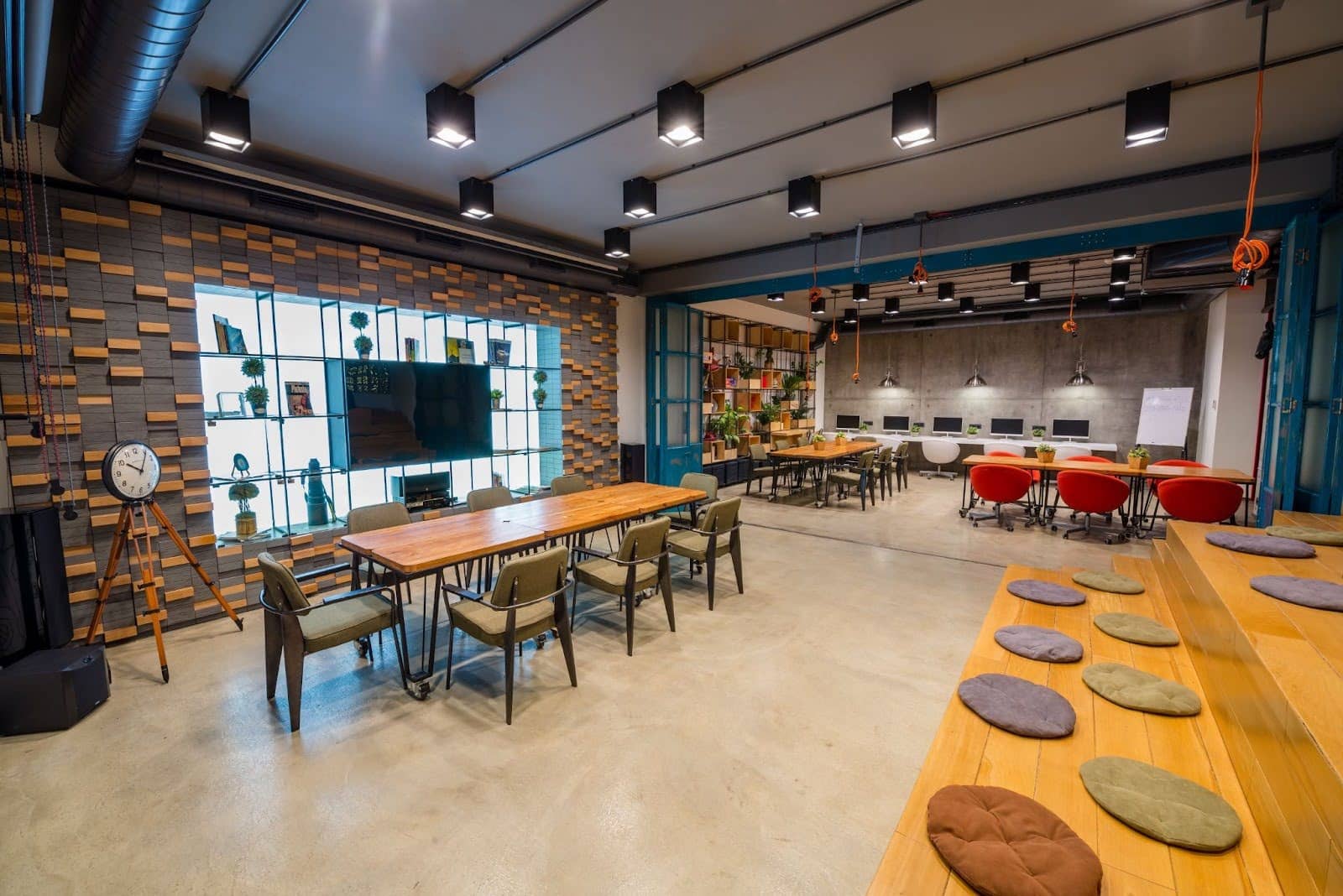
Member spotlight presentation areas are versatile zones where members can showcase their work, lead talks, or host community events. This coworking space design idea builds engagement and adds value by turning your space into a platform for members.
Showcasing members helps them grow their network, gain visibility, and feel more invested in the community.
Why this design works:
- Builds Community: Encourages knowledge sharing and peer learning.
- Attracts New Members: Events create buzz and draw in potential clients or collaborators.
- Adds Flexibility: The space can double as a lounge or meeting zone when not in use.
Practical design tips:
- Include tiered bleacher seating or movable chairs for easy reconfiguration.
- Install a mounted screen or projector with sound support.
- Add soft lighting and neutral backdrops to keep the focus on the speaker.
13. 24/7 Accessible Reception Zones

24/7 accessible reception zones allow members to enter and use the coworking space at any time, with minimal staff involvement. This coworking space design idea supports flexible work hours and modern business needs.
Freelancers, startups, and remote workers don’t always follow a 9-to-5 schedule. Offering round-the-clock access can be a huge selling point.
Key benefits:
- Supports Flexibility: Members can work on their own schedule, including nights and weekends.
- Reduces Staffing Needs: Digital kiosks handle check-ins and visitor management without requiring a receptionist.
- Improves Security: Systems track who enters and leaves, even during off-hours.
Smart setup tips:
- Install touch-screen kiosks or QR code scanners for self check-in.
- Use secure access cards or mobile entry apps to control door access.
- Place clear signage and automated lighting to guide members after hours.
14. Multi-Use Hotdesking Areas
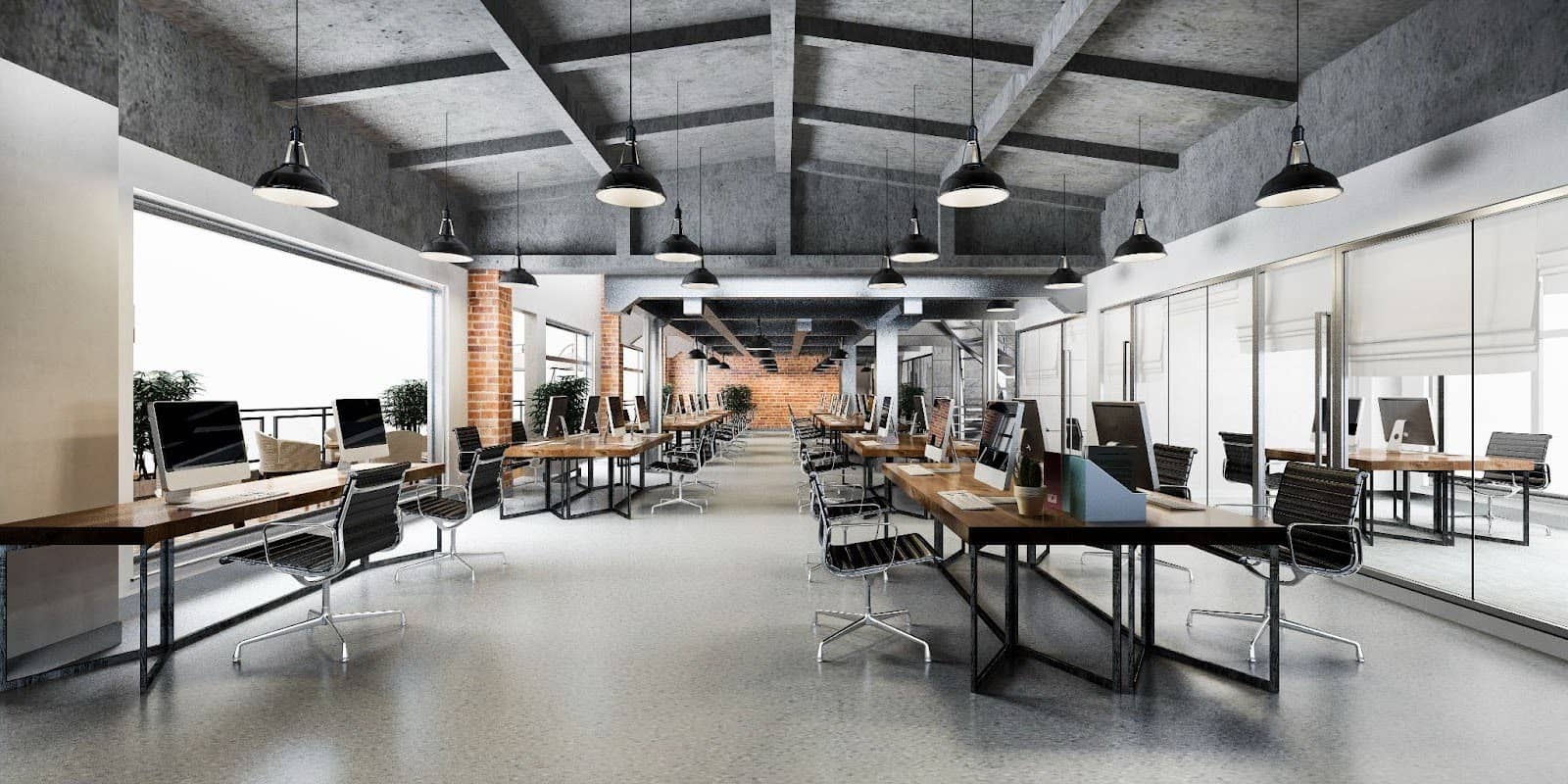
Multi-use hotdesking areas provide flexible, shareable workspaces that support various tasks and user preferences. This coworking space design idea maximizes space efficiency while catering to freelancers, remote teams, and drop-in members.
Hotdesking isn’t just about saving space—it’s about offering versatility without assigning fixed desks.
Why hotdesking works well:
- Optimizes Floor Space: Desks are always in use, reducing wasted capacity.
- Encourages Mobility: Members can choose where to sit based on their needs each day.
- Fosters Connection: Rotating seating arrangements spark new conversations and collaborations.
How to enhance hotdesking zones:
- Use tables with built-in power and privacy panels for comfort and convenience.
- Combine open seating with adjacent booths or pods for quiet work options.
- Offer an online booking system so members can reserve spots easily.
15. Contemporary Themes For Each Zone
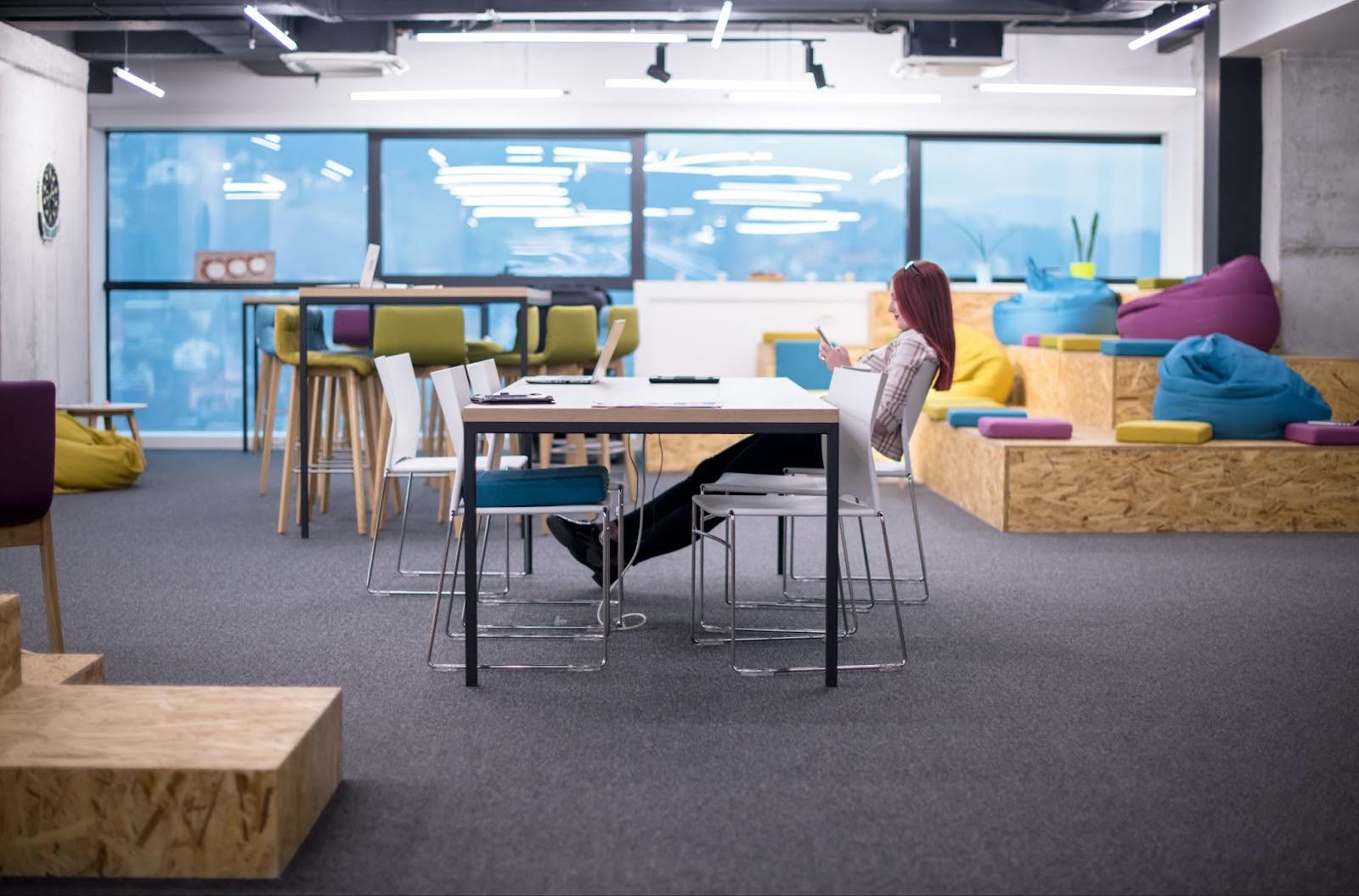
Designing each zone with a unique contemporary theme adds visual interest and gives members a choice of environments that match their mood or task. This coworking space design idea brings personality and variety into your office layout.
People don’t work the same way every day. Offering themed spaces helps them pick where they’ll feel most productive or inspired.
Why this approach stands out:
- Boosts Engagement: A fresh, themed setting can re-energize someone’s workday.
- Supports Personalization: Members can choose zones that match their preferences or workflow.
- Enhances Brand Identity: Curated themes reinforce your coworking space’s uniqueness.
Examples of themed zones:
- A minimalist area with neutral colors and clean lines for focused tasks.
- A retro-inspired corner with bold colors and vintage furniture for creative work.
- A luxe lounge space with soft lighting and plush materials for informal meetings.
16. Social Spaces That Spark Connections
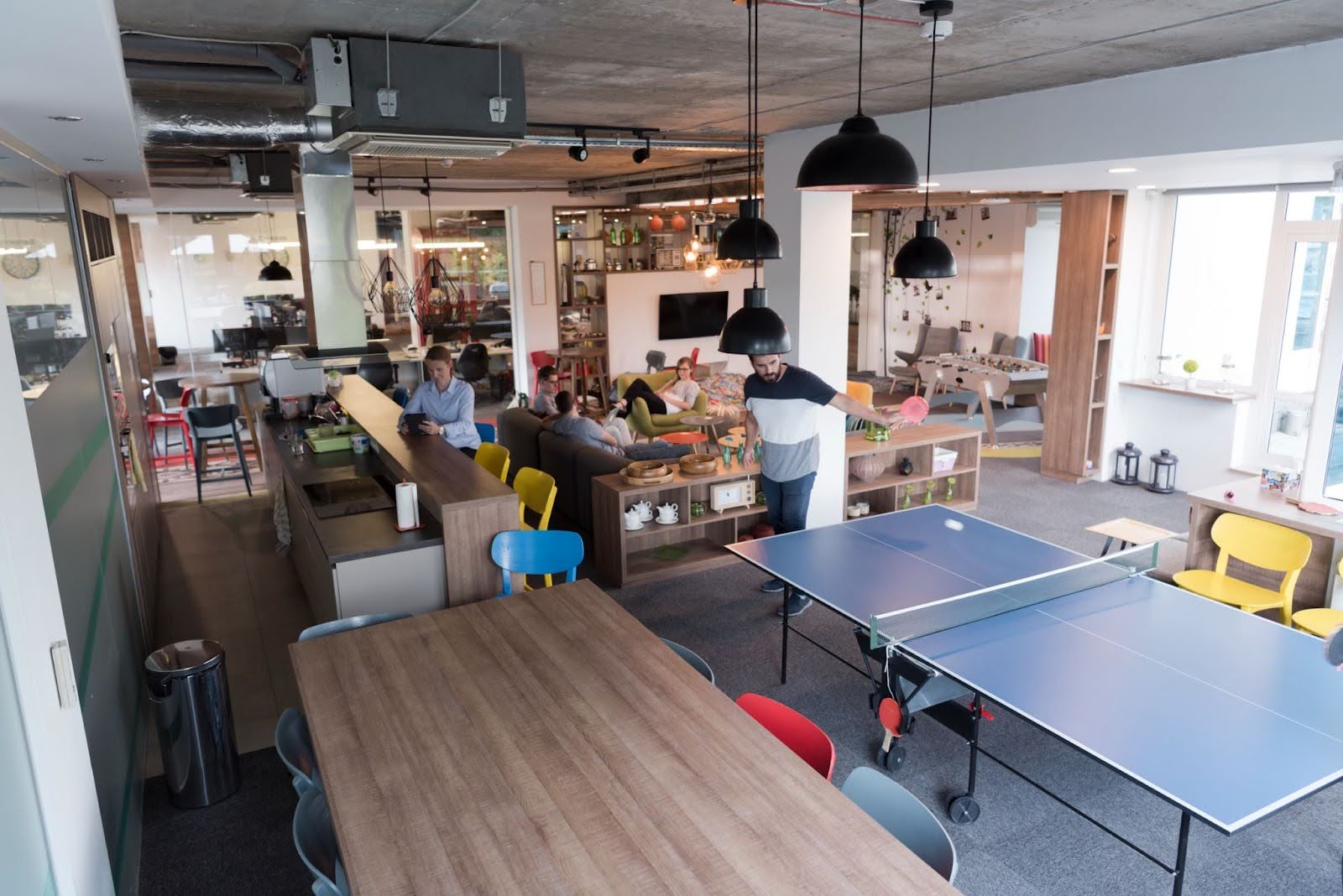
Social spaces are designed to encourage casual conversations, networking, and community building. This coworking space design idea turns everyday interactions into valuable relationships.
Members often find new opportunities not just at their desks, but through informal chats over coffee or during breaks.
Why social zones are essential:
- Foster Community: Helps members form personal and professional connections naturally.
- Encourage Collaboration: Conversations in relaxed settings often lead to new ideas or partnerships.
- Increase Member Retention: A friendly, welcoming environment keeps people coming back.
Effective design features:
- Include café-style tables, bar seating, or lounge chairs in open areas.
- Add communal bookshelves or interactive elements like message boards.
- Use warm lighting, music, and decor to make the space feel approachable.
17. Brand-Customizable Private Offices
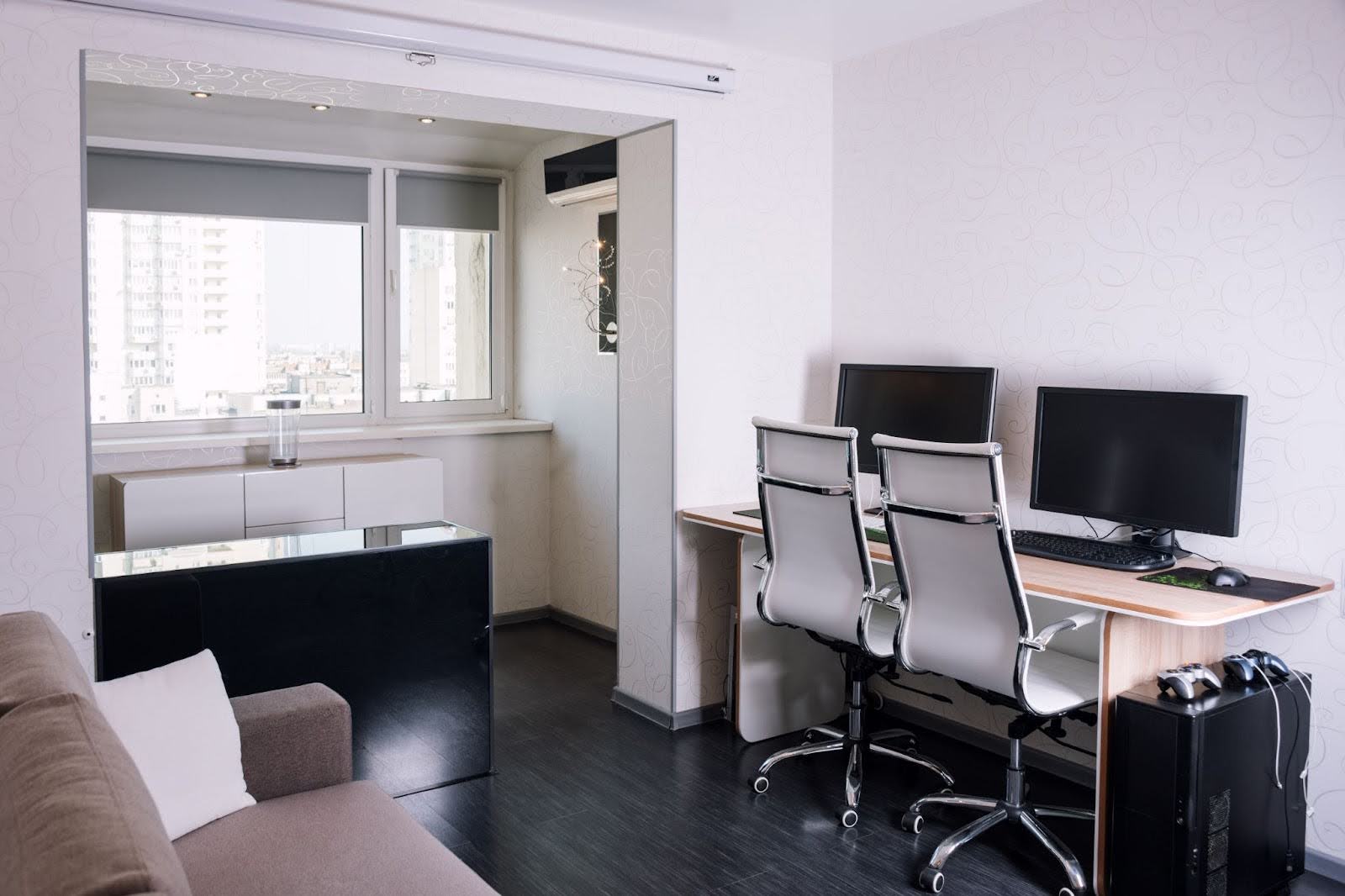
Brand-customizable private offices give small teams or freelancers their own space while allowing them to reflect their identity and culture. This coworking space design idea offers privacy with a personal touch.
For many businesses, especially startups, having a branded workspace helps establish professionalism and comfort.
Why this setup is valuable:
- Increases Member Loyalty: Teams feel more at home in a space that reflects their brand.
- Improves Focus and Privacy: A dedicated room minimizes distractions and secures confidential work.
- Attracts Small Businesses: Companies looking to scale appreciate the flexibility with personalization.
Custom features to offer:
- Options for branded decals, logo signage, or color-themed decor.
- Adjustable layouts with preferred furniture or wall displays.
- Lockable doors and access controls for added security.
18. Statement Lighting Fixtures
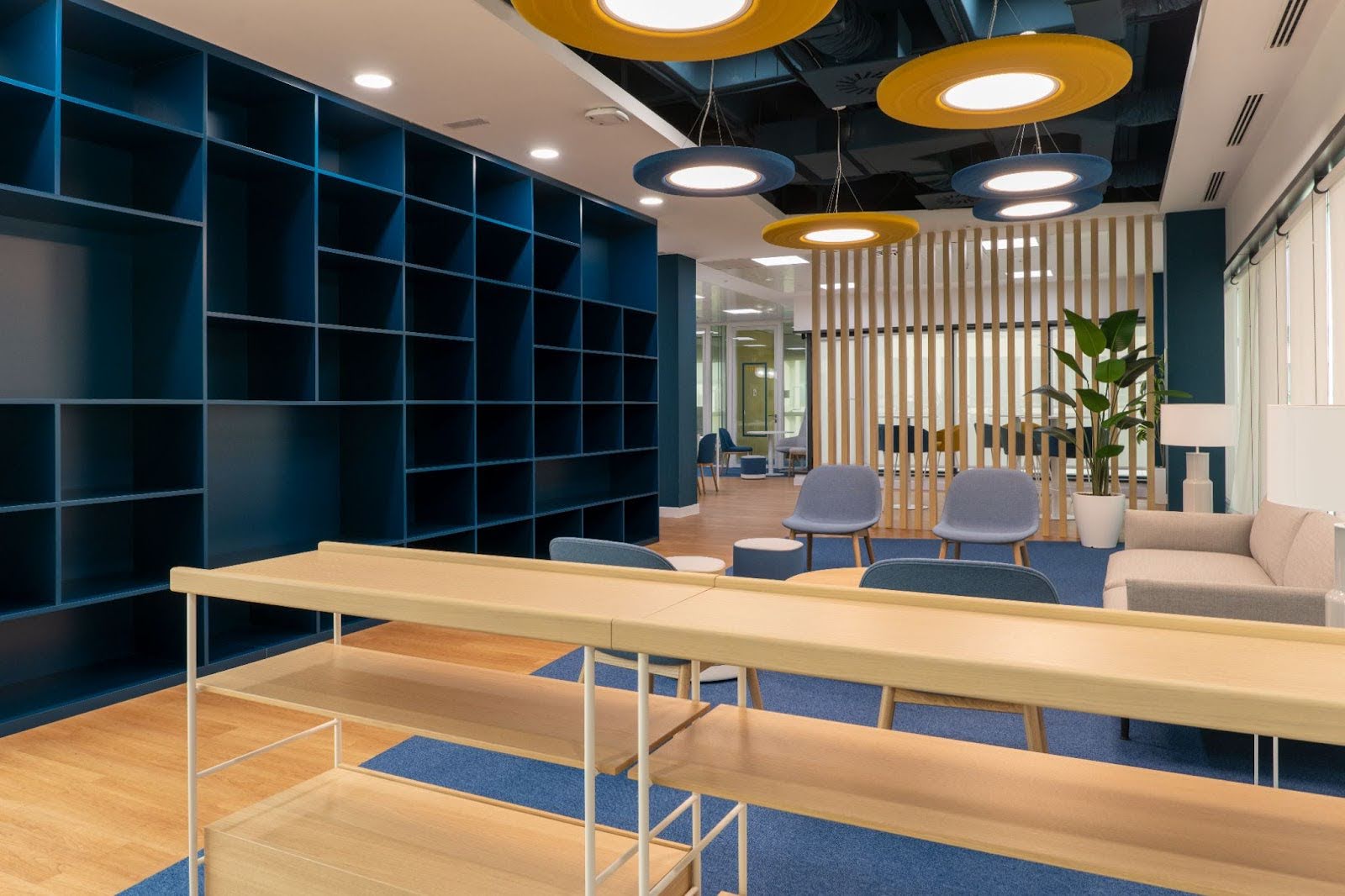
Statement lighting fixtures elevate the look and feel of your coworking space while supporting comfort and functionality. This coworking space design idea blends aesthetics with purpose, making lighting a core design feature—not just a necessity.
Lighting affects how people feel, focus, and interact in a space. The right fixtures can transform an ordinary office into a stylish, energizing environment.
Why lighting design matters:
- Improves Mood and Productivity: Warm, adjustable lighting helps reduce fatigue and supports concentration.
- Defines Zones: Unique lighting can visually separate lounge areas, workstations, or meeting rooms without walls.
- Enhances Style: Eye-catching fixtures become part of your brand experience.
Design suggestions:
- Use pendant lights over lounge areas to add character and warmth.
- Install dimmable LEDs in meeting rooms and focus zones for versatility.
- Choose sculptural or artistic lights that double as design highlights.
19. Community-Centric Common Areas
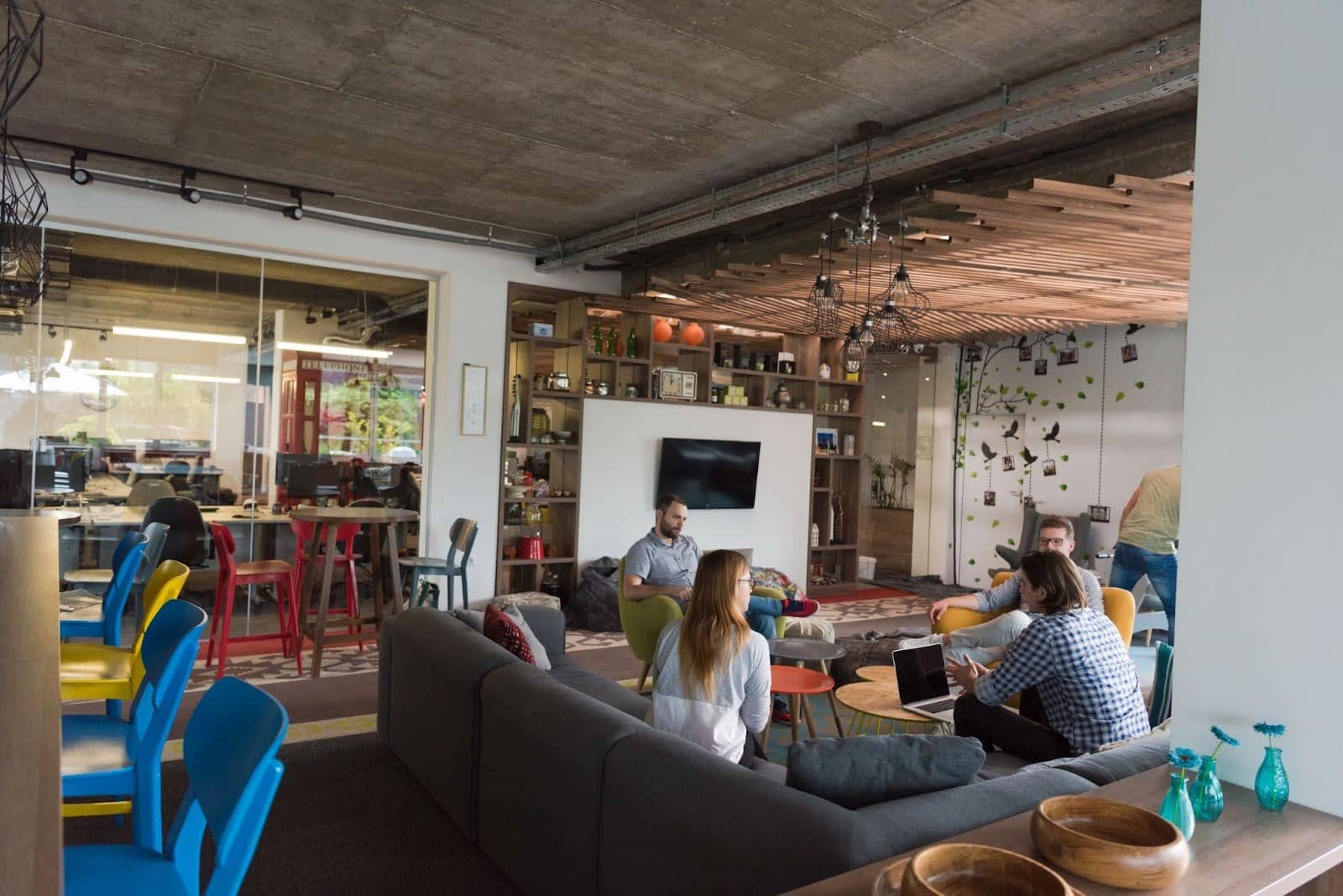
Community-centric common areas are shared spaces designed to foster interaction, collaboration, and a strong sense of belonging. This coworking space design idea transforms passive zones into active community hubs.
These spaces aren’t just walkways or waiting areas—they’re opportunities to build relationships and culture.
Why they’re effective:
- Strengthen Connections: Encourage spontaneous chats and networking between members from different industries.
- Support Events and Gatherings: Serve as flexible venues for meetups, workshops, or celebrations.
- Increase Engagement: A lively common area makes the space feel more inviting and inclusive.
Design tips to make it work:
- Add versatile seating like bean bags, ottomans, or lounge clusters.
- Include community boards, digital screens, or rotating displays for announcements and promotions.
- Use soft lighting and greenery to keep the mood warm and relaxed.
20. Wellness Nooks And Rest Pods
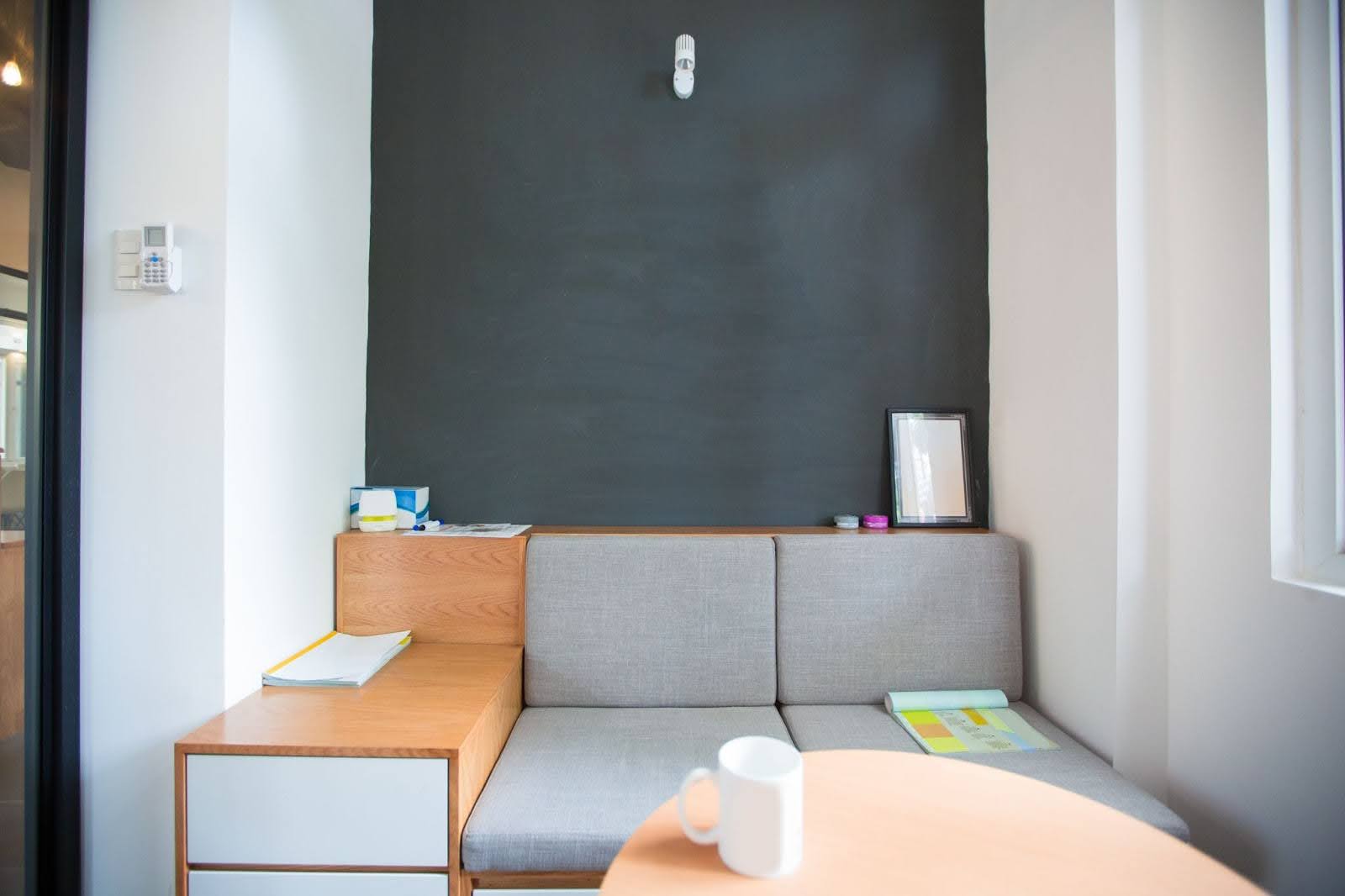
Wellness nooks and rest pods offer quiet, comfortable spaces where members can relax, recharge, or take short breaks during the day. This coworking space design idea supports mental health and productivity by encouraging intentional downtime.
Work can be intense, especially in fast-moving environments. Having a space to breathe makes a big difference.
Why they matter:
- Reduces Burnout: Short rest periods help prevent fatigue and improve focus.
- Supports Well-Being: Shows members that their health is a priority, not just output.
- Boosts Productivity: Even 15 minutes in a rest pod can restore energy and clarity.
What to include:
- Recliner chairs, bean bags, or nap pods with adjustable lighting.
- Soft furnishings, noise-reducing materials, and calming colors.
- Optional additions like aromatherapy, blankets, or guided meditation audio.
21. Standing Desks & Active Zones

Standing desks and active zones promote movement and better posture, offering members healthier ways to work throughout the day. This coworking space design idea supports physical wellness while improving energy and focus.
Sitting all day can lead to fatigue and discomfort. Active workstations help counter that without interrupting productivity.
Why it’s a smart design choice:
- Encourages Better Posture: Standing desks reduce the strain caused by long sitting hours.
- Boosts Energy: Light movement throughout the day helps prevent the afternoon slump.
- Supports Wellness Culture: Shows your space values long-term health, not just convenience.
How to incorporate active zones:
- Offer height-adjustable desks so members can switch between sitting and standing.
- Add anti-fatigue mats, footrests, and ergonomic accessories.
- Designate small open areas for light stretching, walking calls, or desk-side exercises.
Conclusion About Coworking Space Design Ideas in Singapore
Creating the right coworking space design is key to building a productive, inspiring place where people love to work. Every design element, from layout to lighting, plays a role in how your team feels, collaborates, and performs each day.
Ideas like centralised seating, biophilic elements, wellness pods, and flexible furniture layouts help strike the right balance between functionality and style. When thoughtfully combined, these features create spaces that are not only efficient but also uplifting and enjoyable.
Need help turning your space into something truly special? Yangs Design Associates specialises in coworking design and other commercial interiors including retail, food and beverage, and healthcare. Our full in-house team of carpenters, mechanical and electrical experts, and drafters, along with 300-plus staff in Singapore, ensures every project is delivered efficiently and expertly.
Let’s start planning today to start your transformation.
Frequently Asked Questions About Coworking Space Design Ideas in Singapore
What Are The Best Coworking Space Design Ideas?
The best ideas include open layouts, flexible furniture, biophilic elements, wellness pods, and tech-friendly workstations. These designs improve comfort, collaboration, and productivity.
How Do I Design A Productive Coworking Space?
Focus on comfort, natural light, and noise control. Include a mix of quiet zones, collaboration areas, and modern tech setups.
Why Is Interior Design Important In Coworking Spaces?
Good design impacts how people feel, work, and interact. It helps attract members, boosts satisfaction, and supports business growth.
What Furniture Is Best For Coworking Spaces?
Use ergonomic chairs, height-adjustable desks, and modular furniture. Choose flexible pieces that adapt to different users and tasks.
How Much Does It Cost To Design A Coworking Space?
Costs vary depending on size, materials, and features. A basic setup can be affordable, while premium designs require a larger budget.
Can I Customize My Office In A Coworking Space?
Yes, many coworking spaces offer branded private offices. You can often personalize furniture, decor, and layout to fit your brand.
Do You Only Design Coworking Spaces?
No. We also handle commercial projects across industries such as retail, food and beverage, and healthcare, bringing the same attention to detail and user experience.
What Makes Your Team Different From Other Design Firms?
We have full in-house capabilities—carpentry, mechanical and electrical, and drafting—which allow us to manage projects more efficiently and ensure design consistency at every stage.
Can Your Team Handle Large-Scale Coworking Projects?
Yes. With over 300 workers based in Singapore, we are well-equipped to handle large and multi-phase coworking developments.

